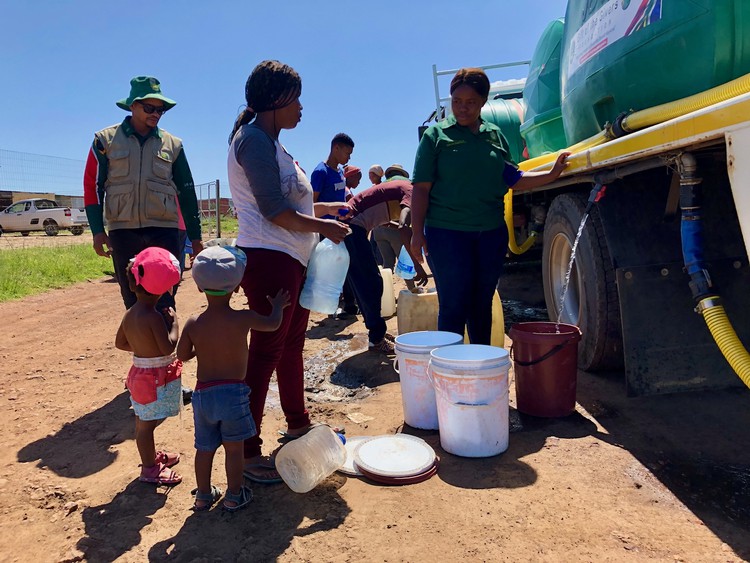No end to water rationing in Makhanda
Water crisis could have been avoided, says residents’ association
Despite the rain in January, Makhanda remains in the grip of a water crisis. Schools, businesses and local residents continue to struggle to cope with water cuts implemented by Makana Municipality.
The municipality recently started a new rotational plan to ration water for the town of over 70,000 people. Water is cut every third day.
However, some areas report water outages at irregular times which go on for days on end. Hendrick Jantjies, a ward committee member from Hooggenoeg, said the water in his area is often cut for three days, sometimes a week at a time.
“It’s hard without water. You can’t use your toilet … You can’t buy it [drinking water] when you are poor,” he said.
Last year a rain tank was donated which has helped with “our survival”, he said. “We didn’t even get her name [the donor] to thank her,” said Jantjies.
Zoleka Kate, principal of Fikizolo Primary in Joza, where the taps have run dry, said, “We had tanks, but they were empty. We were trying to get water from the municipality, but they did not deliver. There were times when we had to ask parents to come fetch their children because there was no water.”
Kate said she relies on “good samaritans” for support. The Jojo tanks at the school were donated and filled up by the Gift of the Givers, which has been organising emergency drought relief in the area since February 2019.
“With 575 learners you can imagine what the toilets were like,” said Kate.
The January rains have helped fill the JoJo tanks, improving the situation at the school. However, Kate said that she is still trying to get funding to attach pumps from the JoJo tanks to the toilets.
Eastern Cape Department of Education spokesperson Loyiso Pulumani said that the department had recommended schools close early if they do not have water on the premises. He said the schools in the area surrounding Makhanda, and some schools in the township, have been worse affected.
Water cuts have seen businesses close temporarily. Earlier in the month, the Department of Home Affairs had to shut its doors.
Problems with supply system
Water is supplied to Makhanda through the Waainek and James Kleynhans treatment works. The James Kleynhans Treatment Works, situated on the east side of town, receives its raw water from the Orange and Fish rivers, but its capacity is limited to ten megalitres per day.
Waainek Treatment Works, situated on the west side of town, receives most of its water from Howiesons Poorthas dam, but only has eight megalitres capacity per day.
The dam level has recently risen to about 50% capacity, while the Settlers dam is at 5%. Both dams ran dry last year, forcing the municipality to only supply water from the James Kleynhans Treatment Works, which had to operate at above design capacity at 12 megalitres per day. The daily demand of the town is 18 megalitres per day.
Makana’s newly appointed Water and Sanitation manager Gubevu Maduna says that currently the water in Howiesons Poort would last about two months were Waainek to be run at full capacity.
Maduna says that the municipality is launching an investigation into why the Settlers dam is not replenishing, especially after the recent rains.
Maduna said the plan is for long-term sustainability, not immediate relief and water rationing would continue.
Some local residents complain that the municipality has not done enough for poorer areas, leaving communities to rely on the support of Gift of the Givers and other community organisations.
Crisis could have been avoided
The municipality maintains that the water crisis was an unavoidable consequence of the extreme drought gripping the region, but Philip Machanick, chairperson of the Grahamstown Residents Association (GRA) says that the crisis could have been avoided if the 2015 planned upgrade for the James Kleynhans Treatment Works had been completed. The upgrade would have doubled its pumping capacity to 20 megalitres a day. Instead, the completion date kept on being pushed back until it became clear that the project was not going to be completed.
In 2019, when the water situation was at its worst, the provincial government intervened and brought in Amatola Water, a company which specialises in providing and managing sanitation and water supply services to municipalities, to facilitate the stalled project.
The R100-million project was supposed to be finished by 2020, but was stalled again.
Machanick said that the “government promised to fast track it” but has not done so.
Maduna said that Amatola Water had left the municipality in the dark during the tender process. He said he was frustrated at how long it has taken for Amatola Water, the implementing agent for the project, to award the contract.
Amatola Water spokesperson Nosisa Songayise confirmed that the contract had finally been awarded to Mamlambo Construction in January this year, after it was put out to tender in May 2019. The project is meant to be finished by March 2021.
The failure to supply water was cited in the Unemployed People’s Movement’s successful bid to get the Makana Municipality dissolved and put under administration. The provincial government is busy appealing the ruling, which is due to be heard in the Grahamstown High Court on the 3 March.
Support independent journalism
Donate using Payfast

Don't miss out on the latest news
We respect your privacy, and promise we won't spam you.
© 2020 GroundUp.
This article is licensed under a Creative Commons Attribution-NoDerivatives 4.0 International License.
You may republish this article, so long as you credit the authors and GroundUp, and do not change the text. Please include a link back to the original article.

